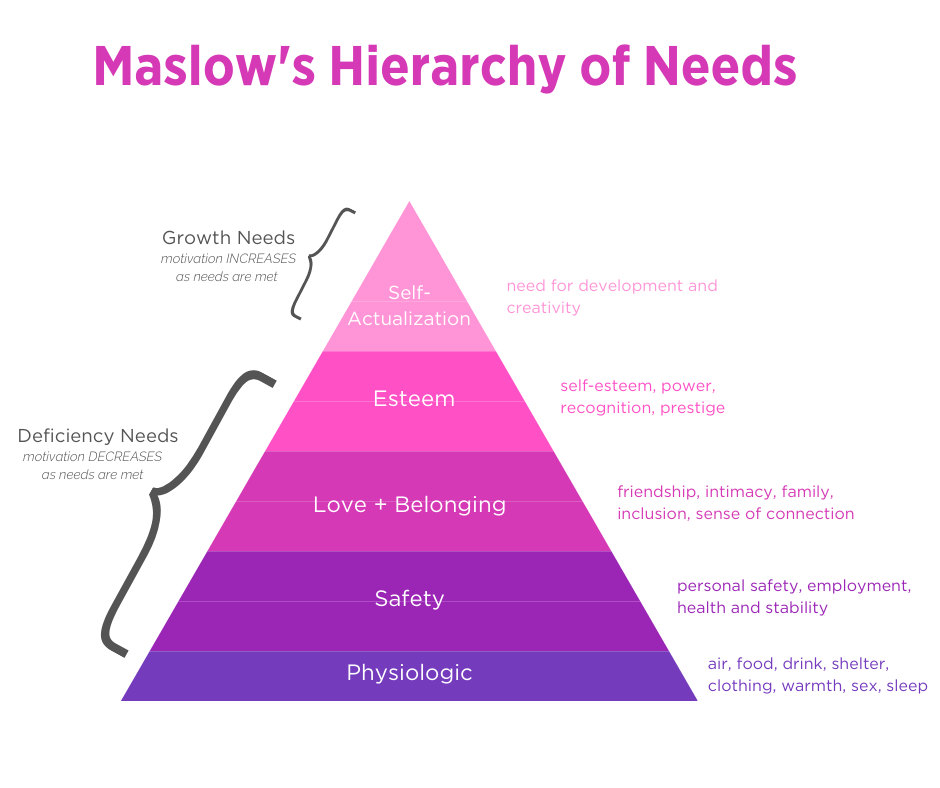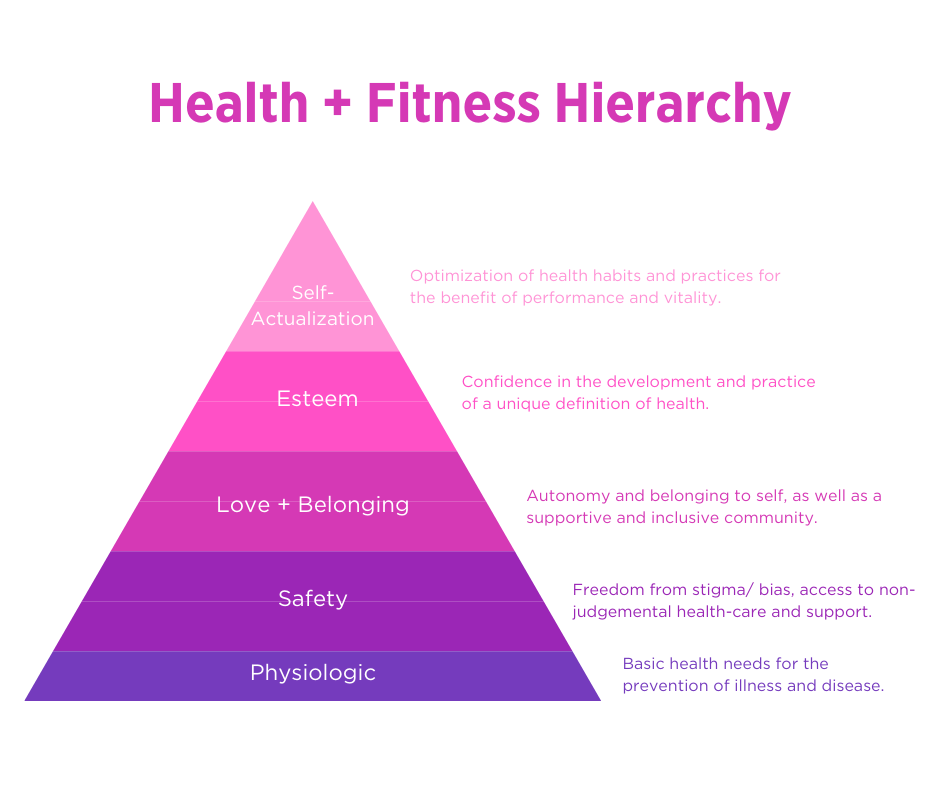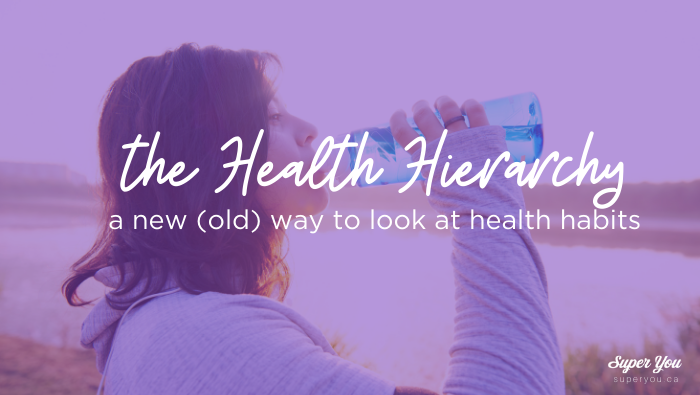Do you ever feel like you’re clear on what health habits you need to develop to improve your health and well-being, but the making it happen just feels…impossible. Because so many other things seem to get in the way?!
What if it’s not what health habits you’re tackling, but the order in which you tackle it that’s the “missing link” for lasting health?! In this article I’m pulling out my psych 101 archives for a review of Maslow’s Hierarchy of needs. I believe that within that model we can draw clues to help us better navigate health and the development of lasting habits!
But first, the backstory:
In 1943, psychologist Abraham Maslow published a very influential paper, A Theory of Human Motivation. He proposed that healthy human beings have needs that can be arranged in a hierarchy. Hence, the “hierarchy of needs.”
It went like this: at the bottom was physiologic needs. Those would be your basic human needs like air, food, water, sleep, clothing, reproduction. Then there was Safety, which included needs for personal safety, employment, health and stability. Next was Love and Belonging (friendship, intimacy, family, inclusion, sense of connection). After that was Esteem (esteem for self and others including self-esteem, power, recognition, prestige). And Self-Actualization (realization of growth and potential, seeking personal growth and peak experiences).
Maslow posited that it’s more difficult for the higher level needs to come into focus if the majority of lower level needs are unmet.
Maslow, in modern day terms:
Anecdotally we can all likely relate to this. Right now we’re in a pretty significant state of stress. As such we’re experiencing varying degrees of unmet needs:
- If you’ve lost your job or your business is in jeopardy your safety needs are in question.
- As we face increased restrictions our needs of love and belonging may be at risk.
- For some, the capacity to maintain food security or shelter means their Physiologic Needs are unmet. A considerable number of people are under financial burden. This impacts stress, and sleep, among other physiologic and safety needs.
Which begs the question, why on earth do we think we should be in Esteem or Self-Actualization? “Getting in the best shape of your life!” Or, “starting a new side hustle to protect yourself!” Or, “developing a new hobby or skill!”
Most people are simply struggling to get by right now. And the Heirarchy of Needs perfectly explains why. It’s ok if we’re not in a “growth” phase right now. In fact it’s 100% normal. Instead of feeling compelled to bake bread or learn a new language right now, focus on your foundation needs.
And, once this Pandemic is over (which it will be, eventually), consider how you generally approach health and fitness. I would suggest that the majority of us are “jumping” past foundation needs straight to Self-Actualization (and it’s not doing us any favours).
Let’s start by exploring Maslow’s Hierarchy.
Growth vs. deficiency needs and motivation:
Maslow referred to the bottom four levels as “deficiency needs” because we don’t tend to notice them unless our needs are unmet. He referred to the 5th level of Self-Actualization as a “growth need” because it stems from a desire to grow as a person.

What happens when our needs aren’t met?
If our needs aren’t met Maslow proposed that we’d be likely to feel a sense of anxiety or distress (anyone feeling this way? Yeah, me too some days!).
This anxiety or distress then motivates us to seek to affect change and have our needs met. Within deficiency needs our motivation decreases as we meet the needs. Within growth needs our motivation increases as we meet the needs.
Let me clarify this with an example.
- If you’ve got enough food to eat you’re not likely to notice this need. However, if you’re struggling to get food on the table, you’re likely to be experiencing some anxiety and distress around this unmet need.
- If you have a safe home, you’re not likely to notice this need. Or, if you’re living in an unsafe home OR you don’t have a home, you’re very likely to experience distress about this unmet need.
- If you have good friends and family that surround and support you, you’re not likely to notice the need of love and belonging. But if you are isolated in quarantine or have experienced being bullied or ostracized, you’ll very likely feel anxiety and distress about your lack of love and belonging.
Is the hierarchy fixed or fluid?
In his original theory Maslow also suggested that if the first four levels are not met, the 5th “growth need” of Self-Actualization is not likely to be within our capacity simply because it requires us to have the capacity for growth. He later clarified that there is possibly more fluidity to the levels and suggested that it might be flexible based on external circumstances or individual differences.
Let’s clarify this with another example:
If you were trying to do something that required you to push your personal boundaries and grow as an individual, consider how it would go if you were not currently feeling supported within the first 4 levels. How would your ability to be creative, innovative and challenge your perceived capabilities if you were also dealing with any of the following:
- You’re homeless, or your home wasn’t safe (physiologic and safety needs unmet).
- You are struggling with food security and having enough to eat was a constant stressor (physiologic needs unmet).
- You’re under slept because you were working multiple jobs to make ends meet (physiologic and safety needs unmet).
- You don’t have friends and family supporting you (love and belonging needs not met).
- You feel insecure about your capabilities (esteem needs unmet).
These are just a few examples, but I suspect that most people would respond that it would be quite challenging to pursue that growth need and achieve self-actualization. Sure, you might be able to persevere (humans are resilient and there are always examples of brilliant people pushing the boundaries when the odds are stacked against them). But would it be optimal? Would you be capable of your best work? Quite possibly not.
But wait, there’s more…
In more recent years Maslow added additional levels to the hierarchy to address what he saw as two areas within Esteem needs: Cognitive Needs (knowledge and understanding, curiousity, exploration, need for meaning and predictability), and Aesthetic Needs (appreciation and search for beauty, balance, form, etc.).
He also capped the hierarchy with an additional level called “transcendence needs.” He defined Transcendence Needs as the experiences beyond the personal self (ex. mystical experiences, experiences with nature, aesthetic experiences, sexual experiences, service to others, pursuit of sciences, religious faith, etc.)
Cool Gillian, but why does this matter to me?
Great question! I think what this theory of human motivation offers us some insight into how to prioritize and remain objective in the face of challenges as we strive towards meeting our needs.
If you’re working on a project that requires your imagination and creativity (ego/ self-actualization), make sure your physiologic, safety, and love and belonging needs are being met!
If you’re underslept (physiologic needs unmet), your job is uncertain (safety needs tenuous) or you’re dealing with interpersonal conflict (love and belonging in question), perhaps recognize that you are experiencing some significant deficiency needs and may need to prioritize those needs being met prior to anything else.
I think this is really important! So often in our culture there is an expectant drive to push, do and be more. This constant pursuit of growth and evolution. And while that is important (and awesome), it’s not always optimal. And I wonder how much happier and healthier we’d be as a collective if we acknowledged when our deficiency needs were unmet and actively worked on them, before we set out striving for self-actualization and transcendence.
How this relates to your pursuit of health, fitness and well-being:
I went down the rabbit hole of Maslow’s Hierarchy of Needs because I was writing about food labeling and how I think it relates to our need to belong. As I explored the ideas of love and belonging within the hierarchy I realized this needed to be an entirely separate blog, because as I re-explored this psychological theory of motivation (I first learned about it in my university psychology classes back in the late 90’s), a penny dropped.
The pursuit of health, fitness and well-being, hierarchy style:
Typically as a culture we approach the creation of a healthy lifestyle in a top level “self-actualization” approach. Instead of focusing on the foundation habits that support our bsic health and well-being, we tackle a specific fitness plan designed to “optimize” our health. Instead of ensuring we are getting enough food and a variety of nutrients to support the prevention of disease, we focus on following very specific nutritional guidelines and rules.
What if we instead started with our foundation needs of physiology and safety, and grew from there?
Before I get into what that looks like, let’s first explore my vision for a Health + Fitness Hierarchy and what I mean by each.

Physiologic Needs:
This includes matters such as food security. It also includes foundation health habits that help us prevent disease and injury. Habits such as adequate sleep, stress management and functional physical activity (such that we can perform activities of daily living).
Safety Needs:
At this level where we’re focused on meeting our physical and psychological safety needs. Physical needs such as our ability to perform our job. Or psychologic needs such as freedom from stigma or bias in matters of health and fitness. In order to fully feel psychologically safe, I would posit we need to actively reject Diet Mentality and begin to explore a more body positive and/or Health at Every Size (HAES®) approach.
Love and Belonging Needs:
We recognize our need for autonomy when it comes to health and fitness. We feel freedom to be who we are, as we are and have a fulfilling and inclusive community we belong to. From this place, we can begin to bring awareness and clarity to our own unique health and fitness vision, needs, desires and goals.
Esteem Needs:
At this level, Maslow’s later revisions to the hierarchy are highly relevant. You might recall, at this level he later categorized Esteem into two areas: Cognitive Needs (knowledge and understanding, curiousity, exploration, need for meaning and predictability), and Aesthetic Needs (appreciation and search for beauty, balance, form, etc.). We begin to develop confidence in and practice our own unique definition of health. Actively pursuing knowledge and exploring new ideas and finding meaning in our personal pursuit of health. We might be drawn to seek our own unique definition of beauty and balance.
Note: I would posit “beauty and balance” has more to do about how we feel than how we physically look if we’re also actively seeking meaning (ie. don’t get ‘hung up’ on the word aesthetic, I’m not off my body positive rocker).
This is also where we develop increased levels of body trust. Through attunement (listening to) and respect (honouring what we hear).
Self-Actualization Needs:
We begin to become more present to what I would consider “fine tuning” of health and fitness pursuits and routines. We’ve established the foundation of the hierarchy. We’re generally healthy and well. We’ve got established health habits and practices that are relevant and meaningful to us as individuals. We’re confident in our approach to practicing those habits. Now, we’re ready for a space of evolution and pursuit of growth.
We are highly attuned to our bodies and listening to our own unique needs and responses. So we can begin to explore what “optimal” health might look like to us. I would consider things like challenging yourself to a specific fitness goal like running a 10k or marathon might fall here. Or fine tuning nutrition to achieve more optimal performance, energy or vitality.
What about Transcendence?
Maslow explored this as the experiences beyond the personal self (ex. mystical experiences, experiences with nature, aesthetic experiences, sexual experiences, service to others, pursuit of sciences, religious faith, etc.). Perhaps this is where we dig into the more spiritual side of health (if we view health within the model of body/ mind/ spirit, which I do). Perhaps this is where we pursue growth like extended meditation or more spiritual forms of yoga or philosophy.
Where does this leave us?
This blog got long. And it got a bit more philosophically “out there,” but circle back with me, I think it could be game changing.
The challenge is that within the traditional health and fitness model we tend to start at Self-Actualization. We’re trying to do the things to “optimize” when we don’t yet have our foundation set. You see the problem don’t you?!
I know, yikes! No wonder so many of us are on the struggle bus!
Explore where you are in the hierarchy:
Get curious and ask yourself some of the following questions…
Physiologic Needs:
- Do you have food security, are you getting enough sleep and managing stress?
- Are you able to move your body such that you can keep up with your activities of daily living comfortably?
- If not, how might you support yourself in this area? What can you do to better fulfill these needs?
Safety Needs:
- What about physical or psychological safety needs?
- Do you feel as though you have the fitness to adequately perform for the purposes of your job/ life?
- Do you feel psychologically safe within the framework of your health and fitness needs? Free from stigma and bias?
- What can you do to actively find support structures with a Body Positive/ Health at Every Size (HAES®) framework?
- What can you do to reject Diet Mentality and develop a better relationship with your body?
- Think about your Environment (people, places, things). How you can actively shift your environment to better support and reduce distractions/ contradictions?
Love and Belonging Needs:
- Do you believe that your health will be as unique as you are?
- Have you fully rejected the authoritarian approach to health and fitness?
- Do you feel autonomous in your pursuit of health and fitness?
- Do you trust and respect your body?
- How might you develop autonomy and body trust?
Esteem Needs:
- Do you have a unique definition of health? What is it?
- How do you bring that definition to life through habits and practices?
- Is this approach to health meaningful and fulfilling to you?
- If not, do you give yourself permission to adjust course as needed?
Self-Actualization Needs:
- What does optimal health look like for you (right now)?
- How can you optimize your habits and practices to enable you to have increased levels of fulfillment, energy and vitality?
- What does “next level” health look like for you?
- Does the pursuit of that vision feel meaningful for you?
A final word:
Remember, your foundation needs must be mostly met before you can begin to explore Self-Actualization. If you find yourself jumping to Self-Actualization, get curious about what foundation needs might support your growth towards that Self-Actualization. Then start there and slowly and intentionally scaffold up towards your bigger broader vision.
Need some support? I’d love to chat and help you find your path to Self-Actualized Health! Connect with me for a complimentary one-to-one connection call.
References:
While much of this is my own theoretical postulating, I made use of some fantastic online resources in the development of this blog. You can explore them here, here and here. I also stumbled onto Dietitian Ellyn Satter’s “Hierarchy of Food Needs” which I found inspiring as I explored this more holistic philosophical health model. You can check out her hierarchy here.
